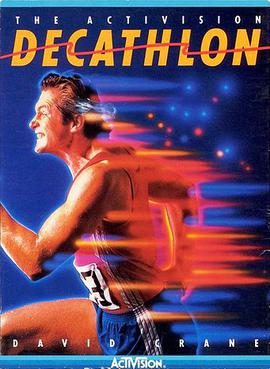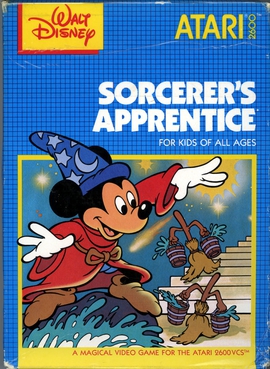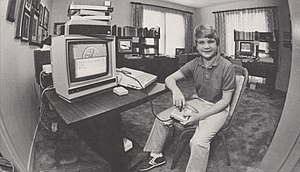
The Atari 2600 is a home video game console developed and produced by Atari, Inc. Released in September 1977, it popularized microprocessor-based hardware and games stored on swappable ROM cartridges, a format first used with the Fairchild Channel F in 1976. Branded as the Atari Video Computer System from its release until November 1982, the VCS was bundled with two joystick controllers, a conjoined pair of paddle controllers, and a game cartridge—initially Combat and later Pac-Man.
Infocom was an American software company based in Cambridge, Massachusetts, that produced numerous works of interactive fiction. They also produced a business application, a relational database called Cornerstone.

Zork is a text-based adventure game first released in 1977 by developers Tim Anderson, Marc Blank, Bruce Daniels, and Dave Lebling for the PDP-10 mainframe computer. The original developers and others, as the company Infocom, expanded and split the game into three titles—Zork I: The Great Underground Empire, Zork II: The Wizard of Frobozz, and Zork III: The Dungeon Master—which were released commercially for a range of personal computers beginning in 1980. In Zork, the player explores the abandoned Great Underground Empire in search of treasure. The player moves between the game's hundreds of locations and interacts with objects by typing commands in natural language that the game interprets. The program acts as a narrator, describing the player's location and the results of the player's commands. It has been described as the most famous piece of interactive fiction.

Activision Publishing, Inc. is an American video game publisher based in Santa Monica, California. It serves as the publishing business for its parent company, Activision Blizzard, and consists of several subsidiary studios. Activision is one of the largest third-party video game publishers in the world and was the top United States publisher in 2016.
Sierra Entertainment, Inc. was an American video game developer and publisher founded in 1979 by Ken and Roberta Williams. The company is known for pioneering the graphic adventure game genre, including the first such game, Mystery House. It is known for its graphical adventure game series King's Quest, Space Quest, Police Quest, Gabriel Knight, Leisure Suit Larry, and Quest for Glory, and as the original publisher of Valve's Half-Life series.
The video game crash of 1983 was a large-scale recession in the video game industry that occurred from 1983 to 1985, primarily in the United States. The crash was attributed to several factors, including market saturation in the number of video game consoles and available games, many of which were of poor quality. This along with waning interest in console games in favor of personal computers. Home video game revenues peaked at around $3.2 billion in 1983, then fell to around $100 million by 1985. The crash abruptly ended what is retrospectively considered the second generation of console video gaming in North America. To a lesser extent, the arcade video game market also weakened as the golden age of arcade video games came to an end.

Pitfall! is a video game developed by David Crane for the Atari Video Computer System and released in 1982 by Activision. The player controls Pitfall Harry, who has a time limit of 20 minutes to seek treasure in a jungle. The game world is populated by enemies and hazards that variously cause the player to lose lives or points.

Miner 2049er is a platform game developed for the Atari 8-bit family of home computers by Bill Hogue and released by his company, Big Five Software, in 1982. The player controls Bounty Bob through multiple levels of a mine, with the goal of traversing all of the platforms while avoiding or defeating enemy mutants. At a time when "climbing games" such as Donkey Kong had four screens, Miner 2049er had ten.

Temple of Apshai is a dungeon crawl role-playing video game developed and published by Automated Simulations in 1979. Originating on the TRS-80 and Commodore PET, it was followed by several updated versions for other computers between 1980 and 1986.

Ghostbusters is a licensed game by Activision based on the film of the same name. It was designed by David Crane and released for several home computer platforms in 1984, and later for video game console systems, including the Atari 2600, Master System and Nintendo Entertainment System. The primary target was the Commodore 64 and the programmer for the initial version of the game was Adam Bellin. All versions of the game were released in the USA except for the Amstrad CPC and ZX Spectrum versions, which were released only in Europe, and the MSX version, which was released only in Europe, South America, and Japan.
Universal Press Syndicate (UPS), a subsidiary of Andrews McMeel Universal, was an independent press syndicate. It distributed lifestyle and opinion columns, comic strips and other content. Popular columns include Dear Abby, Ann Coulter, Roger Ebert and News of the Weird. Founded in 1970, it was merged in July 2009 with Uclick to form Universal Uclick.
Cathryn Mataga is a game programmer and founder of independent video game company Junglevision. Under the name William, she wrote Atari 8-bit family games for Synapse Software in the early to mid 1980s, including Shamus, a flip-screen shooter.
Bill Kunkel was a graphic novelist as well as pioneering professional wrestling and video game journalist and critic from the 1970s until his death in the early 2010s. During his time working with the video game industry, Kunkel authored numerous strategy guides, co-designed several video games, served as an expert witness in three court cases, and taught courses in Game Design for the University of Nevada, Las Vegas (UNLV). Kunkel served as the executive editor of Electronic Games Magazine and the editor-in-chief of Tips & Tricks magazine, writing columns and comics for several magazines and game sites. He often wrote under nicknames, the most common of which were "The Game Doctor", and "Potshot".

The Activision Decathlon is a sports game written by David Crane for the Atari 2600 and published by Activision in 1983. It was ported to the Atari 8-bit family, Atari 5200, Commodore 64, ColecoVision, and MSX. Up to four players compete in the ten different events of a real-life decathlon, either in sequence or individually.
Games by Apollo Inc. was a third-party developer of games for the Atari 2600 video game system, based in Richardson, Texas. It was founded in October 1981 by Pat Roper as a subsidiary of his National Career Consultants (NCC). Apollo's first title was Skeet Shoot, and neither it nor the ten games that followed caught on, and the company was one of the first to declare bankruptcy as a result of the video game crash of 1983.
The 1980s was the second decade in the industry's history. It was a decade of highs and lows for video games. The decade began amidst a boom in the arcade business with giants like Atari still dominating the American market since the late-1970s. Another, the rising influence of the home computer, and a lack of quality in the games themselves led to an implosion of the video game market that nearly destroyed the industry in North America. It took home consoles years to recover from the crash, but Nintendo filled in the void with its Nintendo Entertainment System, reviving interest in consoles. Up until this point, most investors believed video games to be a fad that has since passed. In the remaining years of the decade, Sega ignites a console war with Nintendo, developers that had been affected by the crash experimented with the more advanced graphics of the PC, and Nintendo released the Game Boy, which would become the best-selling handheld gaming device for the next two-decades. Other consoles releases in the decade included the Intellivision, TurboGrafx-16 and Sega Genesis. Notable games of the 1980s included Metroid, Elite, SimCity, Ninja Gaiden, Tetris, Pac-Man, Contra, Donkey Kong, and the first five Super Mario games.
Video game journalism is a branch of journalism concerned with the reporting and discussion of video games, typically based on a core "reveal–preview–review" cycle. With the prevalence and rise of independent media online, online publications and blogs have grown.

Sorcerer's Apprentice is a video game for the Atari 2600, based on a sequence from the film Fantasia.

Kid Vid Grid is a tile-matching full motion video puzzle game developed by Geffen Records and published by Jasmine Multimedia Publishing for Windows in 1994. It is a spin-off of the original Vid Grid, which was released on the same year, and is it also the second entry in the franchise of the same name.

RealSports Baseball is a 1982 sports video game developed and published by Atari, Inc. originally for the Atari 2600. It was also launched on the Atari 5200 and 7800 machines. A version for the Atari 8-bit family of home computers was also in development, but it was cancelled.











